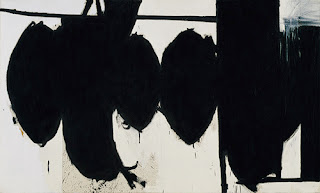This is an interesting mixed show of contemporary painters in London at the Arch 402 Gallery, some abstract, some semi-abstract, figurative and cross-disciplinary. This is showing until 10 June, 2011 (gallery hours: Wed-Fri 11-6, Sat-Sun 11-3 PM).
 |
| Roger Kelly, 'Separator' 2011 |
Phillip Allen, Edwin Aitken, Andrew Bick, Simon Burton, Varda Caivano, Leigh Clarke,
'A Sort of Night to the Mind, A KIND OF NIGHT FOR OUR THOUGHTS', an exhibition of twenty-three UK based artists engaged with painting. Curated by Moyra Derby and Bob Matthews, the exhibition will also host a series of talks and educational events led by some of the featured artists.
Two alternative translations of Honoré de Balzac’s description of illusion from the 1832 short story ‘The Purse’ provide the title for this exhibition. First shown at The Herbert Read Gallery at the University for the Creative Arts in Canterbury, ‘A Sort of Night to the Mind, A KIND OF NIGHT FOR OUR THOUGHTS’ demonstrates the recurring relevance of illusion and in counterpoint, materiality. Illusion and materiality can be argued as so inevitable in the context of painting as to hardly warrant remark, but at the same time they muster such historically resonant responses and strength of feeling that they can feel like a prompt to take sides. However it is an interest in the productive play between these two qualities of a marked surface that has brought this group of works together, an acknowledgment of the imaginative potential of oppositions; “In the half light the physical tricks used by art to make things seem real disappear completely.... At that hour illusion reigns supreme; perhaps it comes with the night? Is not illusion a kind of night for our thoughts, a night which we furnish with dreams.'
 |
| Andrew Bick, oil on canvas, 2010 |



